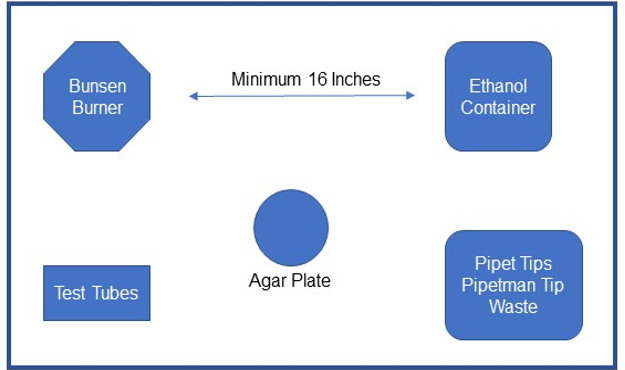Last Revised: July 19, 2024
Revision (original) 4/2020
Flame sterilization is a standard microbiology technique. If possible, disposable sterile inoculating loops and cell spreaders should be substituted for flame sterilization to eliminate the need for open flame. If this technique must be used, researchers must ensure that the ethanol and other sources of combustion are not too close to the open flame, and that the open flame is positioned in a place which limits the passage of your hands near the fire. Researchers must adhere to the following steps when flame sterilizing on the open bench.
PPE and Attire
Personal protective equipment, including a lab coat, gloves, and safety glasses MUST BE WORN. Tie back long hair and remove dangling jewelry. Appropriate lab attire, including long pants and close toed shoes are required in all Penn labs.
Work Area Preparation
Clean your work bench and remove all unnecessary items from the immediate work area, especially flammable items and chemicals. Ensure that no combustible materials are on shelves above or below the work area. Note the location of the nearest eye wash and emergency shower.
Ethanol Preparation
Pour ethanol into a secondary container made of PYREX GLASS or METAL, wide enough to dip a spreader or inoculating loop. Check the integrity of glass containers to ensure they are free of cracks or chips. The container should have an easily replaceable lid to smother ignited ethanol. Only a small volume of ethanol is needed, enough to cover the end of the loop or spreader (approximately 1 cm or less in depth or about 10 ml in volume). An ideal container is a Pyrex Glass Petri Dish. Clean up any ethanol that may have spilled while pouring from the stock bottle into the container before beginning work.
Workflow
Review and organize the work area before each use.
The ethanol container should be kept as far away as is reasonable from the flame and should be positioned in the work area so that it is not necessary to pass the flamed sterile instrument back over the ethanol container prior to immediate use. Ensure all ethanol is burned off before moving the instrument to back over the main work area.
Liquid cultures and petri dishes should be kept reasonably close to the flame to maintain a sterile environment by utilizing the updraft of air created by the flame.

Emergency Response
If the ethanol ignites a fire that cannot be smothered, evacuate the area while notifying others of the fire.
During a fire emergency, the University of Pennsylvania’s Division of Public Safety – Fire and Emergency Services (FES) emphasizes safe evacuation as top priority. While evacuating, shut the fume hood sash (if applicable) and close doors behind you. Notify emergency services of the fire and its location by either of the following methods:
- Pulling the nearest fire alarm manual pull station while you evacuate the building,
- If on the Philadelphia campus, calling 215-573-3333, or 511 from a campus phone.
- If at New Bolton Center or Morris Arboretum & Gardens Call 911.
General fire response information and emergency contact numbers for other Penn campuses can be found at Emergency Info.